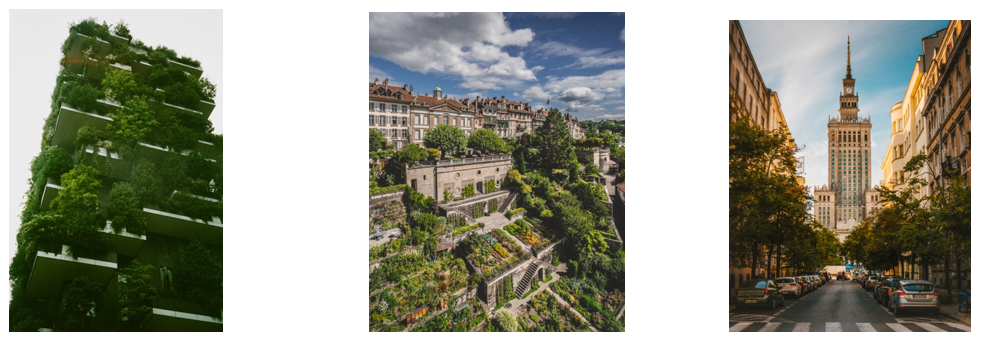Introduction to Urban Heat Islands
As cities continue to grow, so does the problem of urban heat islands (UHIs). UHIs are created when there is a lack of vegetation and an abundance of pavement and buildings, which absorb and radiate more heat than natural surfaces. This can make cities up to 10°F-15°F hotter than their surroundings.1 Tree and vegetation can mitigate this by providing shading and cooling through evapotranspiration.
Trees provide shade that helps cool the air and reduce the heat absorbed by pavement and buildings. They also evaporate water from their leaves, which cools the atmosphere through evapotranspiration. In addition, trees help reduce air pollution and improve mental health and well-being.
It is vital to plant the right tree in the right place to maximize its cooling effect. The best trees for mitigating UHIs are those with large leaves that provide dense shade. Fast-growing trees are also beneficial as they quickly offer cooling benefits.
The Causes of Urban Heat Islands
A heat island is a metropolitan area that is significantly warmer than its surrounding rural areas. The leading cause of heat islands is the replacement of natural landscapes (such as trees and vegetation) with built environments (such as asphalt and concrete). These built surfaces have a low albedo, meaning they absorb more heat from the sun than they reflect. Conversely, trees and vegetation have high albedo, reflecting more sunlight than they absorb.
Another cause of heat islands is the “heat island effect.”2 This occurs when warm air near the ground is trapped by taller buildings, causing the air to become even more generous. The island effect is most pronounced during calm weather conditions when there is little wind to mix the air around.

(Figure 1) During the day, surface temperatures are more variable than atmospheric air temperatures, but at night, they are often similar. Because water does not absorb the sun’s energy in the same way that structures and paved surfaces do, it maintains a relatively constant temperature day and night. This is demonstrated by the dips and spikes in surface temperatures over the pond region. Cooler places can be created within a metropolis via parks, wide open spaces, and bodies of water. Borders between suburban and rural areas often see cooler temperatures than metropolitan centres.
There are several ways to mitigate urban heat islands, including planting trees and increasing vegetation cover, installing green roofs, and using reflective materials on surfaces such as roads and rooftops. Trees are particularly effective at mitigating heat islands because they provide shade and evaporative cooling, which help lower temperatures.
The Effects of Urban Heat Islands
As cities continue to grow and development spreads, the heat generated by these areas, known as urban heat islands (UHIs), has become a significant issue. The effects of these heat islands can be felt in several ways, from higher temperatures and humidity levels to poorer air quality and increased smog.
The good news is that there are ways to mitigate the effects of urban heat islands, and one of the most effective is planting trees. Trees can help cool the air by providing shade and releasing water vapour into the atmosphere. They also help improve air quality by trapping pollutants and dust particles.
In addition to the environmental benefits, trees also have many social and economic benefits. For example, they can increase property values, reduce energy costs, promote tourism, and create jobs.
Mitigating the Effects of Urban Heat Islands
Urban heat islands (UHIs) are created when built environments have higher average temperatures than the surrounding rural areas. The consequences of UHIs are significant, including increased energy use, smog formation, and health problems from heat stress. Trees can play a role in mitigating the effects of UHIs by providing shade and evaporative cooling, which can reduce surface and air temperatures.3 In addition, trees can help reduce energy use by shading buildings and pavement, thereby reducing the need for air conditioning.
Trees and Urban Heat Islands
When we think of trees, we often think of them as being in a natural setting such as a forest. However, trees play an essential role in our urban areas too. For example, trees are important in mitigating the heat island effect. The heat island effect is when urban areas are significantly warmer than rural areas. This is because more hard surfaces in urban areas absorb and radiate heat, while trees and other vegetation help cool the air through evapotranspiration.
While trees are essential in cities for many reasons, their role in cooling the air should not be underestimated. In one study, it was found that planting trees can be an effective way to reduce surface temperatures by up to 8 degrees Celsius4 (46 degrees Fahrenheit). This can make a big difference on hot summer days. Not only does this improve comfort levels for residents, but it can also help to reduce energy use for cooling.

There are many ways to incorporate more trees into urban areas. One way is through green infrastructure such as green roofs and living walls. These structures provide numerous benefits, including cooler air temperatures, improved air quality, and stormwater management. Another way to increase tree canopy cover is planting trees on city streets and parks. Proper tree species selection and care are essential to ensure the long-term health of these urban trees.
The Benefits of Trees in mitigating Urban Heat Islands
Trees are nature’s air conditioners when it comes to mitigating urban heat islands. They cool the air by evaporating water from their leaves, which cools the surrounding air. Trees also provide shade and can reduce the heat absorbed by buildings and pavement.
The benefits of trees in mitigating urban heat islands are many and varied. In addition to cooling the air and providing shade, trees can also help to improve air quality and reduce noise pollution. They can also help to conserve energy by reducing the need for artificial lighting and heating/cooling systems.
Trees are an essential part of any effort to mitigate urban heat islands. Their ability to cool the air and provide shade makes them a valuable tool in combating the effects of climate change.
Planting Trees to Mitigate Urban Heat Islands
Trees play an essential role in mitigating urban heat islands (UHIs). They do this by providing shade, evaporative cooling, and windbreaks. All these factors can help reduce the air temperature and make the city feel more comfortable.
Shade is the most transparent way that trees can mitigate UHIs. By blocking the sun’s radiation, trees can reduce the heat absorbed by asphalt and concrete surfaces. This can significantly impact the surface temperature, which can be up to 10°F cooler in shady areas compared to sunny places.4
Evaporative cooling is another way that trees can help to reduce UHIs. When leaves transpire, they release water vapour into the air. This process cools the air around the tree and can help to offset the heat generated by UHIs.
Windbreaks are another essential tool for mitigating this. Trees can act as barriers to wind, which can help to keep hot air from entering an area and further warming it up. For example, a wall of trees around a city makes it possible to make a “cool island” several degrees cooler than the surrounding area.
Conclusion
In conclusion, urban heat islands are an essential environmental hazard that can significantly impact the health and well-being of city residents. Fortunately, there is evidence that trees can help to mitigate their effects. Planting more trees in cities has been shown to reduce temperatures, lower energy use and pollutant levels, and improve air quality for all. However, to combat urban heat island impacts, we must continue investing in green infrastructure initiatives like tree planting programs that will provide long-term benefits for our planet’s ecosystems.

(Image Source: Photo by Polina Chistyakova: https://www.pexels.com/photo/white-building-exterior-surrounded-trees-and-gardens-2815150/; Photo by Leonard Dahmen: https://www.pexels.com/photo/gray-concrete-buildings-under-blue-sky-2974834/; Photo by Josh Hild: https://www.pexels.com/photo/cars-parked-on-street-near-high-rise-building-2613438/; )
Article References:
- https://joint-research-centre.ec.europa.eu/jrc-news/cities-are-often-10-15-degc-hotter-their-rural-surroundings-2022-07-25_en
- https://www.epa.gov/heatislands/learn-about-heat-islands
- https://earthbound.report/2021/07/14/5-ways-to-reduce-the-urban-heat-island-effect/
- https://onetreeplanted.org/blogs/stories/urban-heat-island

